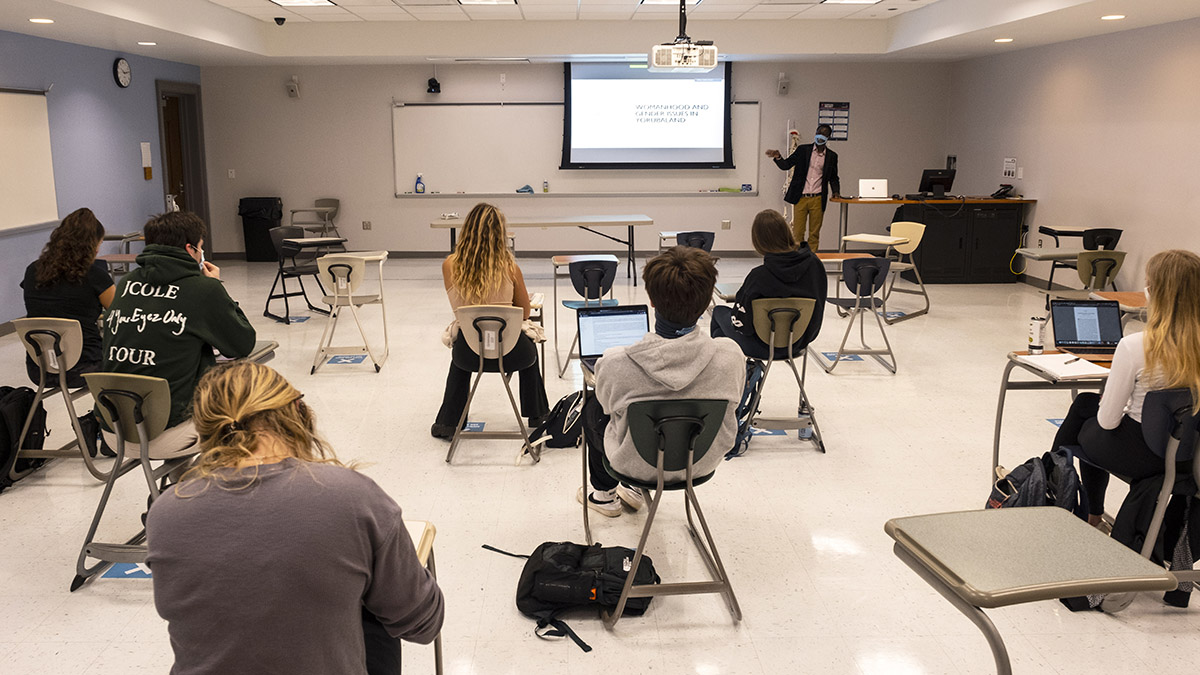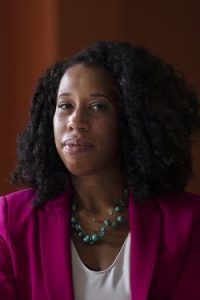In part one of a three-part series, two Carolina experts consider the pandemic’s lasting effects on education from kindergarten through college.

Carolina’s Pandemic Year: This week last March, the University shifted to remote instruction. The Well is marking the occasion with a week of special stories, including ways the University has addressed the crisis, reflections from Chancellor Guskiewicz and, below, predictions from Carolina’s faculty on lasting changes to post-pandemic life.
Teachers and students in kindergarten to high school will feel the effects of the pandemic for much longer than anyone expects. Faculty at colleges and universities will continue with new modes of instruction, while they fold into their teaching an expanded understanding of students’ often demanding lives.
These are some of the ways the pandemic may change education.
In the wake of this past year’s devastation, death and adaptation, The Well asked experts in various fields about how daily life may differ after the crisis lifts.
Kindergarten through college
Cassandra R. Davis knows that it will take a lot longer for schools, teachers and students in kindergarten through 12th grade to recover from the pandemic, even by conservative estimates. Davis, a research professor in the College of Arts & Sciences’ public policy department, looks at education through the lens of natural disasters such as hurricanes, floods and wildfires.

“I look at what happens after a hurricane hits,” Davis said. Recovery typically takes way longer than anticipated. “With hurricanes, there’s a clear start point and a clear end point. For the pandemic, it’s not so clear.”
Davis cites research by the late Robert W. Kates, which initially indicated that for communities affected by Hurricane Katrina in 2005, it would take 20 years to recover. Instead, recovery has proven to be much longer or shorter, depending on resources that a school district had when Katrina arrived.
Natural disasters tend to exacerbate preexisting conditions. “If a community is doing really well economically, then a hazard and natural disaster will likely boost that community [in the long run]. If the community is not doing well, we’ve seen the opposite happen,” Davis said.
Think about Hurricane Katrina’s damage in New Orleans. The tourist areas rebounded, but the Ninth Ward and its low-income community of color has not.
Davis found that North Carolina school districts hit by hurricanes Matthew in 2016 and Florence in 2018 are also experiencing a long recovery. She expects that the pandemic will affect schools similarly.
Four years after Hurricane Matthew left North Carolina with record flooding, 26 deaths and more than 100,000 damaged structures, Davis and her research team surveyed educators in 17 county school districts. “We found that one-fourth of schools had not recovered in measures of student achievement and behavior. “Not even close,” she said. “They were still at the very bottom.”
The most recent study, which focused on 15 districts, indicated that 23% of educators perceived that students had not yet recovered from the two hurricanes.
Unlike a hurricane, the pandemic has no clear end date. “From my perspective, we’re still living in this hurricane. We are actively living in this storm right now,” Davis said.
Davis expects a lagged pandemic recovery and wonders what the recovery time will be. “We can’t assume that it will be back to business as normal, because based on previous disasters — hurricanes, floods, ice storms, fires in California — recovery time is much longer than we ever really anticipate,” she said.
And it’s especially long for low-income communities of color and low-resource communities, Davis said.
When a storm damages infrastructure such as buildings, officials can assess the damage and repair it so that students can return to school. Damage that we can’t see interests Davis. She draws from research on the social and emotional impact that disasters have on students and their schooling and educators and their teaching. As schools recover, Davis urges districts to be patient with teachers, who can become burned out by teaching in stressful situations. The pandemic stresses include teachers caring for their own children or family members or experiencing a death in the family.
“As we strive to make sure that students and their emotional and academic and behavioral needs are met, educators can be left behind,” Davis said. She hopes that schools will institute a regular “pulse check” on educators to see how they are adjusting to the return to classrooms.
Davis leads a multi-university, nationwide study of first-generation college students. Two surveys so far found that the pandemic accelerated what students already often do: care for a child, siblings or another family member and work to help ends meet or because a parent lost a job — all while studying and attending classes. Some 60% of students said that someone in their home, including themselves, had lost a job or been furloughed due to COVID-19.
College faculty could bring that picture into focus for each class by conducting an anonymous survey of their students each semester. “One of my colleagues, Rebecca Kreitzer [assistant professor of public policy], suggested that. Maybe that will become a permanent tool in our teaching toolboxes,” Davis said.
New ways to teach, new understanding of students’ needs
Viji Sathy, professor of the practice in the College’s psychology and neuroscience department and faculty fellow for inclusive teaching, studies undergraduate education, specifically innovative ways of teaching and curriculum creation. She sees college faculty expanding their awareness of students’ lives and foresees promising teaching models that could become permanent.
The pandemic-forced move to remote instruction has fostered different modes of instruction and the need to communicate clearly about course content, structure and expectations. Sathy’s work on Carolina’s instruction modes gives her keen insight into what higher education broadly will look like after the pandemic.

“We’ve had a lot of discussions about how to describe the modes so that it is clear for both faculty and students.” She thinks that universities must provide transparent course information so that students will fully understand course demands such as percentage of synchronous or asynchronous time, number of exams, meeting patterns and group work.
“All those things have implications,” she said. “Students need to consider all of that when building a life schedule, alongside their class schedule.” Carolina is leading in this conversation nationally by building a tool called Class Features to provide this information to students at the time of course registration.
Sathy said that an irony of the pandemic is a greater appreciation by faculty of the differences that exist with students in terms of their commitments outside the classroom. She sees this awareness of some students’ family duties or lack of resources such as reliable internet service that might impede learning as taking root in all corners of teaching and student affairs at Carolina.
This expanded awareness has enabled educators to discuss the effects many things have on students’ education: sibling care, elder care, job loss or having to work, racial and cultural diversity, multigenerational families. “We took for granted that they could manage those things on top of being in their classroom,” Sathy said. “We need systems in place and equitable teaching practices with the flexibility students require to live their lives and to complete their coursework successfully. The pandemic opened all of our eyes wider as to how diverse students’ needs are. We were less engaged in these kinds of discussions prior to the pandemic.
“Now, we can’t turn away from it. While many of us are eager to return to ‘normal’ it would be a shame not to incorporate the lessons learned and cultivate a new normal,” Sathy said.
Teaching practices will change permanently. “Some instructors want to recreate online the magic of being in a classroom together, but the rules are not the same online. We have to adapt our practices,” Sathy said.
The Hybrid-Flexible or “hyflex” teaching method has Sathy’s attention, and she thinks it will remain on many campuses. Hyflex involves some students meeting with the instructor in a classroom as other students participate remotely. Sathy said that faculty on many campuses have used hyflex instruction during the past year.
“Hyflex, when done well, is most intriguing and offers a pathway for more inclusive approaches to education,” Sathy said. “It offers the charm of having students in the classroom, but it’s also accessible to students who can’t make it to campus.”
By Scott Jared, The Well
